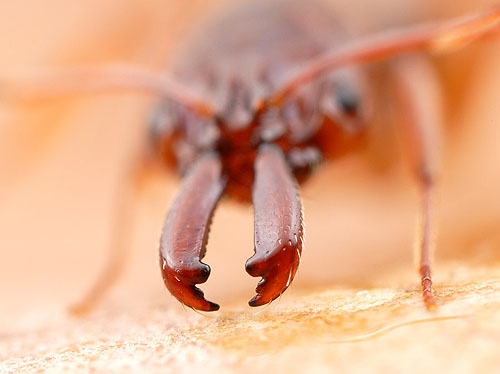
Odontomachus meinerti trap-jaw ant, Argentina
One perk of being at a research university is the opportunity to shoot the various study organisms on campus. These subjects are interesting- they have to be, or they wouldn't be studied- and when the research goes public I get the chance to disseminate my photographs with the science media outlets that cover the story.
Among my favorite campus animals is the Odontomachus trap-jaw ant, one of the focal taxa in Andy Suarez's lab. The researchers are looking at the biomechanics of the jaw, one of the fastest recorded appendages among all animals, and how it evolves to suit the differing ecology of the dozens of species in the group. One of Andy's students works on the structure of the mandible itself, recording where the chitin is the hardest, thickest, and heaviest. I thought it'd be useful to have an image that really draws attention to just the mandibles, and not the ant attached to them.
This is a different sort of image than my usual fare. Most macro work takes place at the small apertures of f/11 to f/18 or so. These settings are pretty standard for insect photography, as they extend the depth of field and bring more of the insect into focus. But every now and then I have reason to go the other direction. Here, I opened the aperture to f/5.6, bringing the mandibles into very sharp detail while the rest of the ant blurs away. Perfect for an illustration of the dense chitin along the jaws' leading edge.
Oh, and here's a shot of the whole animal, at f/13:

Odontomachus meinerti, Argentina
photo details (both images): Canon MP-E 65mm 1-5x macro lens on a Canon EOS 20D
ISO 100, 1/250 sec, twin flash diffused through tracing paper
- Log in to post comments


Great shot Alex! You just made me feel like a springtail. I can't imagine how difficult it must have been to get the tip of the mandibles into the shallow plane of focus.
Those jaws seem to have been used quite a lot, given the wear on the front teeth.
Excellent shot, as usual, Alex. Odontomachus ants pack a double-whammy: trap-jaw mandibles and a potent sting. In the Philippines, they're very aggressive and will readily sting you. They'll grab your skin by their mandibles and stitch a circle with their stinger if you don't flick them off quickly. With a lot of experience with these ants, we've found that if you don't scratch or rub the sting area, it soon feels cool and numb. Better than the burn and itch that you would get if you scratched it. Ask Gary A. about his encounter with Odontomachus banksi (wink).
Love these jaw shots.
I'm discovering I really have a thing for jaws - is that wrong?
Ted- what with your Tiger Beetle thing, who'd have thunk it?